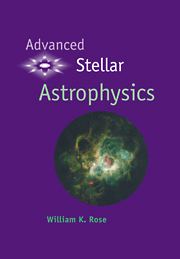Book contents
- Frontmatter
- Contents
- Preface
- 1 Star formation and stellar evolution: an overview
- 2 Introduction to the physics of stellar interiors and the equations of stellar structure
- 3 Statistical physics
- 4 Absorption processes
- 5 Stellar atmospheres, convective envelopes and stellar winds
- 6 Thermonuclear reactions and nucleosynthesis
- 7 Weak interactions in stellar interiors
- 8 Stellar stability and hydrodynamics
- 9 Binary stars, mass accretion, stellar rotation and meridional circulation
- 10 Stellar magnetic fields
- 11 White dwarfs, novae and supernovae
- 12 General relativity
- 13 Neutron stars and black holes
- Appendix 1 Physical and astronomical constants
- Appendix 2 Further comments on the Dirac equation
- Appendix 3 Mathematical appendix
- Appendix 4 Polytropes and the isothermal gas sphere
- Appendix 5 Solutions to selected problems
- References
- Index
8 - Stellar stability and hydrodynamics
Published online by Cambridge University Press: 05 June 2012
- Frontmatter
- Contents
- Preface
- 1 Star formation and stellar evolution: an overview
- 2 Introduction to the physics of stellar interiors and the equations of stellar structure
- 3 Statistical physics
- 4 Absorption processes
- 5 Stellar atmospheres, convective envelopes and stellar winds
- 6 Thermonuclear reactions and nucleosynthesis
- 7 Weak interactions in stellar interiors
- 8 Stellar stability and hydrodynamics
- 9 Binary stars, mass accretion, stellar rotation and meridional circulation
- 10 Stellar magnetic fields
- 11 White dwarfs, novae and supernovae
- 12 General relativity
- 13 Neutron stars and black holes
- Appendix 1 Physical and astronomical constants
- Appendix 2 Further comments on the Dirac equation
- Appendix 3 Mathematical appendix
- Appendix 4 Polytropes and the isothermal gas sphere
- Appendix 5 Solutions to selected problems
- References
- Index
Summary
Pulsational instability
In Chapter 1 we discussed some of the observational properties of periodic variable stars. The instability that drives pulsations in RR Lyrae variables, Cepheids and long-period variables is associated with hydrogen and helium ionization zones. The large heat capacity of these ionization zones causes the phase of maximum luminosity to be delayed by approximately 90° as compared to the phase of minimum radius. Thermonuclear reactions can also cause stars to become pulsationally unstable. Very massive stars and white dwarfs in which thermonuclear runaways are caused by mass accretion from a binary companion become pulsationally unstable as the result of their hydrogen-burning sources. To determine whether a particular star is pulsationally unstable one first determines the structure of the star (i.e. r = r(Mr), P = P(Mr), ρ = ρ(Mr), Lr = Lr(Mr)) and then solves the linearized equation of motion for the oscillatory modes. It is usually adequate to assume that stellar oscillations are adiabatic. If the oscillatory modes of a star have been determined we can evaluate a stability integral which will be derived below. The sign of this stability integral determines whether a particular stellar model is unstable to self-excited oscillations at a particular frequency (eigenmode). We are usually interested only in radial modes of oscillation and in most circumstances only the longest period mode is pulsationally unstable. In β Canis Majoris stars (also known as β Cepheid variables) nonradial oscillatory modes can also become excited.
- Type
- Chapter
- Information
- Advanced Stellar Astrophysics , pp. 260 - 279Publisher: Cambridge University PressPrint publication year: 1998



